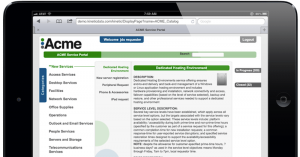What’s New at Kinetic: Building Smart in 2026
At Kinetic, we believe the future of Business Process Management isn’t bigger—it’s smarter.
x
Forward-thinking IT organizations have embraced service catalogs for nearly a decade, as means to enable self-service and reap the attendant cost savings. Business users — whether remote or on-site...

Forward-thinking IT organizations have embraced service catalogs for nearly a decade, as means to enable self-service and reap the attendant cost savings. Business users — whether remote or on-site — can request services from a standard set of IT offerings (e.g., password reset, new laptop, application access) and view the status of any previous request, all without a costly call to the help desk.
At a high level, service catalogs reduce the time and cost of delivering technical services while improving the user experience. These and the other benefits of service catalogs needn’t be limited to the IT provisioning of services however; an expanded view of the service catalog to encompass all shared services groups in the organization (e.g., HR, finance, facilities, etc.) extends the cost savings of service catalogs while also providing employees with a single, intuitive interface for requesting any type of enterprise service.
Back in 2013, Forrester Research published a white paper titled "Master the Service Catalog Solution Landscape in 2013" which identified a number of reasons for undertaking such a business service catalog effort, as well as the benefits to be gained from the initiative. Forrester continued to write about service catalogs in 2014 and 2015, and the topic remains hot, with more than one hundred articles published about service catalogs in just the past year.
Per Forrester’s research, business service catalogs:
A key benefit of this approach is “one-stop shopping” for business users; there’s no need to learn and use separate systems in order to request services from finance, IT, HT, facilities or other groups.
Users don’t care what happens behind the scenes, they just want their request fulfilled.
Everything starts with a request. Providing request and fulfillment capabilities for virtually any business service or product that employees need to do their jobs delivers a smart employee experience.
Indeed, a key element of the enterprise request management (ERM) strategy business process management is integrated analytics, which enable accurate costing, reporting on both quantitative (e.g., elapsed time) and qualitative (user satisfaction) metrics and continuous process improvement.
What could go wrong? Forrester also warns about common inhibitors to BT success, including:
Part one of this series defined the business service catalog concept, and part three will address request management architecture.

At Kinetic, we believe the future of Business Process Management isn’t bigger—it’s smarter.

IT support automation uses software workflows, rule engines, AI/ML, and integrations to automate...

Business process reimagined is the strategic renewal of how work gets done by combining modern digital...